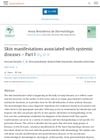Classic Sweet Syndrome: A Case Report
August 2018
in “
Journal of The American Academy of Dermatology
”

TLDR A 54-year-old man with painful skin blisters and fever was diagnosed with Sweet syndrome and successfully treated with corticosteroids.
In the case report of Classic Sweet syndrome, a 54-year-old man presented with symptoms including an upper respiratory tract infection, fever, and painful blisters on the face and arms, which did not respond to antiviral and antibiotic treatment. He also had bilateral conjunctivitis and various skin lesions. Blood tests indicated thrombocytosis, neutrophilic leukocytosis, and an increased erythrocyte sedimentation rate. A skin biopsy confirmed the diagnosis of Sweet syndrome, which is characterized by painful, erythematous-violet nodules or plaques, and is often associated with fever, arthralgias, and myalgias. The etiology of Sweet syndrome is unknown but may be related to drugs, infections, autoimmune, or neoplastic disorders. The patient was treated with systemic corticosteroids (prednisone) and experienced complete resolution of symptoms. Sweet syndrome is diagnosed based on major criteria (abrupt onset of painful nodules or plaques and neutrophilic dermal infiltrate without vasculitis) and at least two minor criteria, which include fever, association with other conditions, and laboratory abnormalities. Treatment typically involves corticosteroids, but other options are available. Early recognition and treatment are crucial for a good outcome.




